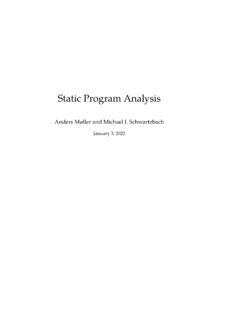Transcription of The Clean Coder: A Code of Conduct For Professional ...
1 Praise for The Clean Coder Uncle Bob Martin definitely raises the bar with his latest book. He explains his expectation for a Professional programmer on management interactions , time management, pressure, on collaboration, and on the choice of tools to use. Beyond TDD and ATDD, Martin explains what every programmer who considers him- or herself a Professional not only needs to know, but also needs to follow in order to make the young profession of software development grow. Markus G rtnerSenior Software Developerit-agile Some technical books inspire and teach; some delight and amuse. Rarely does a technical book do all four of these things. Robert Martin s always have for me and The Clean Coder is no exception. Read, learn, and live the lessons in this book and you can accurately call yourself a software Professional .
2 George BullockSenior Program ManagerMicrosoft Corp. If a computer science degree had required reading for after you graduate, this would be it. In the real world, your bad code doesn t vanish when the semester s over, you don t get an A for marathon coding the night before an assignment s due, and, worst of all, you have to deal with people. So, coding gurus are not necessarily professionals. The Clean Coder describes the journey to professionalism .. and it does a remarkably entertaining job of it. Jeff Overbey University of Illinois at Urbana-Champaign The Clean Coder is much more than a set of rules or guidelines. It contains hard-earned wisdom and knowledge that is normally obtained through many years of trial and error or by working as an apprentice to a master craftsman. If you call yourself a software Professional , you need this book.
3 R. L. BogettiLead System DesignerBaxter page intentionally left blank The Clean CoderThe Robert C. Martin Seriesis directed at software developers, team-leaders, business analysts, and managers who want to increase their skills and proficiency to the level of a Master Craftsman. The series contains books that guide software professionals in the principles, patterns, and practices of programming, software project management, requirements gathering, design, analysis, testing and a complete list of available Robert C. Martin SeriesThe Clean CoderA code OF Conduct FOR Professional PROGRAMMERSR obert C. MartinUpper Saddle River, NJ Boston Indianapolis San FranciscoNew York Toronto Montreal London Munich Paris MadridCapetown Sydney Tokyo Singapore Mexico CityMany of the designations used by manufacturers and sellers to distinguish their products are claimed as trademarks.
4 Where those designations appear in this book, and the publisher was aware of a trademark claim, the designations have been printed with initial capital letters or in all author and publisher have taken care in the preparation of this book, but make no expressed or implied warranty of any kind and assume no responsibility for errors or omissions. No liability is assumed for incidental or consequential damages in connection with or arising out of the use of the information or programs contained publisher offers excellent discounts on this book when ordered in quantity for bulk purchases or special sales, which may include electronic versions and/or custom covers and content particular to your business, training goals, marketing focus, and branding interests. For more information, please contact: Corporate and Government Sales (800) 382-3419 sales outside the United States please contact: International Sales us on the Web: of Congress Cataloging-in-Publication DataMartin, Robert C.
5 The Clean coder : a code of Conduct for Professional programmers / Robert Martin. p. cm. Includes bibliographical references and index. ISBN 0-13-708107-3 (pbk. : alk. paper)1. Computer programming Moral and ethical aspects. 2. Computer programmers Professional ethics. I. Title. 2011 dc22 2011005962 Copyright 2011 Pearson Education, rights reserved. Printed in the United States of America. This publication is protected by copyright, and permission must be obtained from the publisher prior to any prohibited reproduction, storage in a retrieval system, or transmission in any form or by any means, electronic, mechanical, photocopying, recording, or likewise. For information regarding permissions, write to: Pearson Education, Inc. Rights and Contracts Department 501 Boylston Street, Suite 900 Boston, MA 02116 Fax: (617) 671-3447 ISBN-13: 978-0-13-708107-3 ISBN-10: 0-13-708107-3 Text printed in the United States on recycled paper at RR Donnelley in Crawfordsville, printing, May 2011 Between 1986 and 2000 I worked closely with Jim Newkirk, a colleague from Teradyne.
6 He and I shared a passion for programming and for Clean code . We would spend nights, evenings, and weekends together playing with different programming styles and design techniques. We were continually scheming about business ideas. Eventually we formed Object Mentor, Inc., together. I learned many things from Jim as we plied our schemes together. But one of the most important was his attitude of work ethic; it was something I strove to emulate. Jim is a Professional . I am proud to have worked with him, and to call him my page intentionally left blank ixForeword xiiiPreface xixAcknowledgments xxiiiAbout the Author xxixOn the Cover xxxiPre-Requisite Introduction 1 Chapter 1 Professionalism 7Be Careful What You Ask For 8 Taking Responsibility 8 First.
7 Do No Harm 11 Work Ethic 16 Bibliography 22 Chapter 2 Saying No 23 Adversarial Roles 26 High Stakes 29 Being a Team Player 30 The Cost of Saying Yes 36 code Impossible 41 CONTENTSCONTENTSxChapter 3 Saying Yes 45A Language of Commitment 47 Learning How to Say Yes 52 Conclusion 56 Chapter 4 Coding 57 Preparedness 58 The Flow Zone 62 Writer s Block 64 Debugging 66 Pacing Yourself 69 Being Late 71 Help 73 Bibliography 76 Chapter 5 Test Driven Development 77 The Jury Is In 79 The Three Laws of TDD 79 What TDD Is Not 83 Bibliography 84 Chapter 6 Practicing 85 Some Background on Practicing 86 The Coding Dojo 89 Broadening Your Experience 93 Conclusion 94 Bibliography
8 94 Chapter 7 Acceptance Testing 95 Communicating Requirements 95 Acceptance Tests 100 Conclusion 111 Chapter 8 Testing Strategies 113QA Should Find Nothing 114 CONTENTSxiThe Test Automation Pyramid 115 Conclusion 119 Bibliography 119 Chapter 9 Time Management 121 Meetings 122 Focus-Manna 127 Time Boxing and Tomatoes 130 Avoidance 131 Blind Alleys 131 Marshes, Bogs, Swamps, and Other Messes 132 Conclusion 133 Chapter 10 Estimation 135 What Is an Estimate?
9 138 PERT 141 Estimating Tasks 144 The Law of Large Numbers 147 Conclusion 147 Bibliography 148 Chapter 11 Pressure 149 Avoiding Pressure 151 Handling Pressure 153 Conclusion 155 Chapter 12 Collaboration 157 Programmers versus People 159 Cerebellums 164 Conclusion 166 Chapter 13 Teams and Projects 167 Does It Blend?
10 168 Conclusion 171 Bibliography 171 CONTENTSxiiChapter 14 Mentoring, Apprenticeship, and Craftsmanship 173 Degrees of Failure 174 Mentoring 174 Apprenticeship 180 Craftsmanship 184 Conclusion 185 Appendix A Tooling 187 Tools 189 Source code Control 189 IDE/Editor













